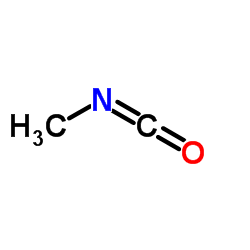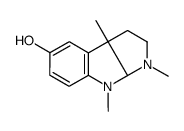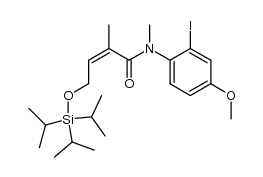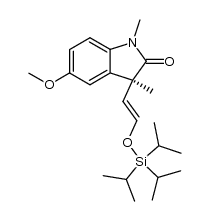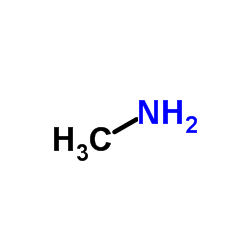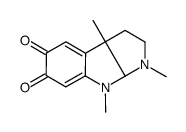57-47-6
| 中文名 | 毒扁豆碱 |
|---|---|
| 英文名 | physostigmine |
| 中文别名 |
依色林,卡拉巴豆碱
依色林 依色林,ESERLNE 1,2,3,3A-六氢-1,3A,8-三甲基吡咯并[2,3-B]吲哚-5-酚甲基氨基甲酸酯 |
| 英文别名 |
Eserine Blue
Antilirium (-)-Eserine EINECS 200-332-8 Eserine Physostigmine (3aS-cis)-1,2,3,3a,8,8a-Hexahydro-1,3a,8-trimethylpyrrolo[2,3-b]indol-5-ol Methylcarbamate (Ester) MFCD00151090 (3aS,8aR)-1,3a,8-Trimethyl-1,2,3,3a,8,8a-hexahydropyrrolo[2,3-b]indol-5-yl methylcarbamate Physostigmine (USP) (3aS,8aR)-1,3a,8-Trimethyl-1,2,3,3a,8,8a-hexahydropyrrolo[2,3-b]indol-5-yl hydrogen methylcarbonimidate (3aS-cis)-1,2,3,3a,8,8a-Hexahydro-1,3a,8-trimethylpyrrolo(2,3-b)indol-5-ol methylcarbamate (ester) [(3aR,8bS)-3,4,8b-trimethyl-2,3a-dihydro-1H-pyrrolo[2,3-b]indol-7-yl] N-methylcarbamate |
| 描述 | Physostigmine (Eserine) 是一种可逆的乙酰胆碱酯酶 (AChE) 抑制剂。Physostigmine 可以穿过血脑屏障,提高大脑中乙酰胆碱的水平。Physostigmine 能逆转阿尔茨海默病转基因小鼠的记忆缺陷。Physostigmine 也是抗胆碱能中毒的解毒剂。 |
|---|---|
| 相关类别 | |
| 体内研究 | 毒扁豆碱(Eserine)(0.03-0.3mg/kg;s.c.;每天一次,持续6周)改善Tg(+)小鼠的上下文和线索记忆缺陷[2]。动物模型:杂合子转基因小鼠(Tg(+)小鼠)[2]剂量:0.03,0.1,0.3mg/kg给药:S.c.;连续6周每天结果:使Tg(+)动物的上下文记忆缺陷趋于正常,使其更接近Tg(-)动物。 |
| 参考文献 |
| 密度 | 1.2±0.1 g/cm3 |
|---|---|
| 沸点 | 422.3±55.0 °C at 760 mmHg |
| 熔点 | 102-104 °C(lit.) |
| 分子式 | C15H21N3O2 |
| 分子量 | 275.346 |
| 闪点 | 209.2±31.5 °C |
| 精确质量 | 275.163391 |
| PSA | 44.81000 |
| LogP | 1.89 |
| 蒸汽压 | 0.0±1.1 mmHg at 25°C |
| 折射率 | 1.616 |
| 储存条件 | 本品应密封于阴凉避光处保存。 |
| 分子结构 | 五、分子性质数据: 1、 摩尔折射率:77.18 2、 摩尔体积(m3/mol):236.0 3、 等张比容(90.2K):602.3 4、 表面张力(dyne/cm):42.3 5、 极化率(10 -24cm 3):30.59 |
| 计算化学 | 1.疏水参数计算参考值(XlogP):无 2.氢键供体数量:1 3.氢键受体数量:4 4.可旋转化学键数量:2 5.互变异构体数量:2 6.拓扑分子极性表面积44.8 7.重原子数量:20 8.表面电荷:0 9.复杂度:403 10.同位素原子数量:0 11.确定原子立构中心数量:2 12.不确定原子立构中心数量:0 13.确定化学键立构中心数量:0 14.不确定化学键立构中心数量:0 15.共价键单元数量:1 |
| 更多 | 1. 性状:无色斜方棱柱状或片状结晶。 2. 密度(g/mL,25/4℃):未确定 3. 相对蒸汽密度(g/mL,空气=1):未确定 4. 熔点(ºC):105~106℃(也有不稳定低熔点的产品,为86~87℃) 5. 沸点(ºC,常压):未确定 6. 沸点(ºC,5.2kPa):未确定 7. 折射率:未确定 8. 闪点(ºC):未确定 9. 比旋光度(º):[α]D17 -76°(C=1.3,氯仿中)、[α]D25 -120°(C=1,苯中) 10. 自燃点或引燃温度(ºC):未确定 11. 蒸气压(kPa,25ºC):未确定 12. 饱和蒸气压(kPa,60ºC):未确定 13. 燃烧热(KJ/mol):未确定 14. 临界温度(ºC):未确定 15. 临界压力(KPa):未确定 16. 油水(辛醇/水)分配系数的对数值:未确定 17. 爆炸上限(%,V/V):未确定 18. 爆炸下限(%,V/V):未确定 19. 溶解性:溶于乙醇、苯、氯仿和油类,微溶于水。 |
|
Section I.Chemical Product and Company Identification Chemical Name Physostigmine free base Portland OR SynonymPyrrolo[2,3-b]indol-5-ol, 1,2,3,3a,8,8a-hexahydro- 1,3a,8-trimethyl-, 5-(N-methylcarbamate), (3aS,8aR)- (CA INDEX NAME); Eserine Chemical FormulaC15H21N3O2
57-47-6 CAS Number Section II.Composition and Information on Ingredients Chemical NameCAS Number Percent (%)TLV/PELToxicology Data Physostigmine free base57-47-6Min. 98.0 Not available.Rat LD50 (oral) 4500 µg/kg (HPLC,T)Mouse LD50 (oral) 3 mg/kg Rabbit LD50 (oral)11200 µg/kg Section III. Hazards Identification Acute Health EffectsToxic if ingested or inhaled. Avoid prolonged contact with this material. Overexposure may result in serious illness or death. Follow safe industrial hygiene practices and always wear proper protective equipment when handling this compound. Chronic Health EffectsCARCINOGENIC EFFECTS : Not available. MUTAGENIC EFFECTS : Not available. TERATOGENIC EFFECTS : Not available. DEVELOPMENTAL TOXICITY: Reproductive effects. Rat TDLo Intraperitoneal 333 µg/kg, male 1 day prior to mating TOXIC EFFECTS: Effects on Fertility - Mating performance Mouse TDLo Intraperitoneal 50 µg/kg, female 13 days of pregnancy TOXIC EFFECTS: Effects on Newborn - Biochemical and metabolic Effects on Newborn - Behavioral Repeated exposure to an highly toxic material may produce general deterioration of health by an accumulation in one or many human organs. Section IV.First Aid Measures Check for and remove any contact lenses. In case of contact, immediately flush eyes with plenty of water for at least 15 Eye Contact minutes. Get medical attention. In case of contact, immediately flush skin with plenty of water for at least 15 minutes while removing contaminated clothing Skin Contact and shoes. Wash clothing before reuse. Thoroughly clean shoes before reuse. Get medical attention immediately. InhalationIf the victim is not breathing, perform mouth-to-mouth resuscitation. Loosen tight clothing such as a collar, tie, belt or waistband. If breathing is difficult, oxygen can be administered. Seek medical attention if respiration problems do not improve. IngestionINDUCE VOMITING by sticking finger in throat. Lower the head so that the vomit will not reenter the mouth and throat. Loosen tight clothing such as a collar, tie, belt or waistband. If the victim is not breathing, perform mouth-to-mouth resuscitation. Examine the lips and mouth to ascertain whether the tissues are damaged, a possible indication that the toxic material was ingested; the absence of such signs, however, is not conclusive. Section V.Fire and Explosion Data Not available. May be combustible at high temperature.Auto-Ignition Flammability Flammable LimitsNot available. Flash Points100°C (212°F) Combustion ProductsThese products are toxic carbon oxides (CO, CO2), nitrogen oxides (NO, NO2). Fire Hazards Not available. Risks of explosion of the product in presence of mechanical impact: Not available. Explosion Hazards Risks of explosion of the product in presence of static discharge: Not available. Continued on Next Page Physostigmine free base Fire Fighting Media SMALL FIRE: Use DRY chemical powder. LARGE FIRE: Use water spray, fog or foam. DO NOT use water jet. and Instructions Consult with local fire authorities before attempting large scale fire-fighting operations. Section VI.Accidental Release Measures Spill CleanupHighly toxic material. Air and light sensitive material. Heat sensitive material. Stop leak if without risk. DO NOT get water inside container. DO NOT touch spilled material. Use water spray to reduce Instructions vapors. Prevent entry into sewers, basements or confined areas; dike if needed. Eliminate all sources of ignition. Consult federal, state, and/or local authorities for assistance on disposal. Section VII. Handling and Storage HIGHLY TOXIC. AIR AND LIGHT SENSITIVE. HEAT SENSITIVE MATERIAL. STORE UNDER INERT GAS. Keep locked Handling and Storage up. Keep away from heat. Mechanical exhaust required. When not in use, tightly seal the container and store in a dry, cool Information place. Avoid excessive heat and light. DO NOT ingest. Do not breathe dust. Wear suitable protective clothing. If ingested, seek medical advice immediately and show the container or the label. Treat symptomatically and supportively. Always store away from incompatible compounds such as oxidizing agents, metals, acids, alkalis (bases). Section VIII. Exposure Controls/Personal Protection Use process enclosures, local exhaust ventilation, or other engineering controls to keep airborne levels below recommended Engineering Controls exposure limits. If user operations generate dust, fume or mist, use ventilation to keep exposure to airborne contaminants below the exposure limit. Splash goggles. Lab coat. Dust respirator. Boots. Gloves. A MSHA/NIOSH approved respirator must be used to avoid Personal Protection inhalation of the product. Suggested protective clothing might not be sufficient; consult a specialist BEFORE handling this product. Exposure LimitsNot available. Section IX. Physical and Chemical Properties Solid. (Off-white crystal.)Solubility Physical state @ 20°CVery soluble in dichloromethane. Soluble in ether, chloroform, Not available.benzene, alcohol, oils. Specific Gravity Slightly soluble in water. Molecular Weight275.35Partition CoefficientLOG Pow: 2.21 Boiling PointNot available.Not applicable. Vapor Pressure Melting Point105°C (221°F)Vapor DensityNot available. Not available.Not available. Refractive IndexVolatility Critical TemperatureNot available.OdorNot available. Not available.Not available. ViscosityTaste Section X.Stability and Reactivity Data Stability This material is stable if stored under proper conditions. (See Section VII for instructions) Conditions of InstabilityAvoid excessive heat and light. Air and light sensitive. Store under inert gas. Turns red on exposure to heat, light, air, and on contact with traces of metals. Incompatibilities Reactive with oxidizing agents, metals, acids, alkalis (bases). Section XI. Toxicological Information TJ2100000 RTECS Number Routes of ExposureEye Contact. Ingestion. Inhalation. Rat LD50 (oral) 4500 µg/kg Toxicity Data Mouse LD50 (oral) 3 mg/kg Rabbit LD50 (oral)11200 µg/kg CARCINOGENIC EFFECTS : Not available. Chronic Toxic Effects MUTAGENIC EFFECTS : Not available. TERATOGENIC EFFECTS : Not available. DEVELOPMENTAL TOXICITY: Reproductive effects. Rat TDLo Intraperitoneal 333 µg/kg, male 1 day prior to mating TOXIC EFFECTS: Effects on Fertility - Mating performance Mouse TDLo Intraperitoneal 50 µg/kg, female 13 days of pregnancy TOXIC EFFECTS: Effects on Newborn - Biochemical and metabolic Effects on Newborn - Behavioral Repeated exposure to an highly toxic material may produce general deterioration of health by an accumulation in one or many human organs. Toxic if ingested or inhaled. Avoid prolonged contact with this material. Overexposure may result in serious illness or death. Acute Toxic Effects Follow safe industrial hygiene practices and always wear proper protective equipment when handling this compound. Continued on Next Page Physostigmine free base Section XII.Ecological Information EcotoxicityNot available. Not available. Environmental Fate Section XIII. Disposal Considerations Recycle to process, if possible. Consult your local regional authorities. You may be able to dissolve or mix material with a Waste Disposal combustible solvent and burn in a chemical incinerator equipped with an afterburner and scrubber system. Observe all federal, state and local regulations when disposing of the substance. Section XIV. Transport Information DOT ClassificationDOT CLASS 6.1: Toxic material. PIN Number Proper Shipping NameAlkaloids, solid, n.o.s. I RQ = 100 (45.4) Packing Group (PG) DOT Pictograms Section XV. Other Regulatory Information and Pictograms TSCA Chemical InventoryThis compound is ON the EPA Toxic Substances Control Act (TSCA) inventory list. (EPA) WHMIS ClassificationCLASS D-1A: Material causing immediate and serious toxic effects (VERY TOXIC). On NDSL. (Canada) EINECS Number (EEC) 200-332-8 EEC Risk StatementsR26/27/28- Very toxic by inhalation, in contact with skin and if swallowed. SECTION 16 - ADDITIONAL INFORMATION N/A |
CHEMICAL IDENTIFICATION
HEALTH HAZARD DATAACUTE TOXICITY DATA
|
| 符号 |

GHS06 |
|---|---|
| 信号词 | Danger |
| 危害声明 | H300 + H330 |
| 警示性声明 | P260-P284-P301 + P310 + P330-P304 + P340 + P310-P403 + P233 |
| 个人防护装备 | Eyeshields;Faceshields;full-face particle respirator type N100 (US);Gloves;respirator cartridge type N100 (US);type P1 (EN143) respirator filter;type P3 (EN 143) respirator cartridges |
| 危害码 (欧洲) | T+ |
| 风险声明 (欧洲) | 26/28 |
| 安全声明 (欧洲) | S23-S45-S25 |
| 危险品运输编码 | UN 1544 6.1/PG 1 |
| WGK德国 | 3 |
| RTECS号 | TJ2100000 |
| 包装等级 | II |
| 危险类别 | 6.1(a) |
| 上游产品 6 | |
|---|---|
| 下游产品 4 | |


